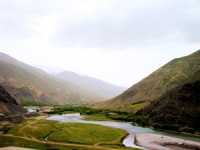Water sharing between Central Asian countries has been conflicting for quite a long time already.
Balancing Water Use

The economies of Afghanistan and the Central Asian countries largely depend on water, the resource that is highly contested not only between upstream and downstream countries, but also between different sectors such as agriculture and energy.
During Soviet Union, the energy and water resources in the Central Asian region were managed at a regional level through central planning and funding. The hydropower stations upstream were operated in an irrigation mode supplying water as well as electricity for irrigated agriculture in the downstream countries; in turn, the downstream countries supplied the upstream countries with energy resources during the winter as well as with food crops. However, since the disintegration of the Soviet Union, the countries decided to opt for self-sufficiency options in order to reduce their dependency on other countries, including their neighbors, thus causing a split of the established regional benefit sharing system. The attempts of the countries to agree through barter agreements were proved to be unsuccessful as they did not fully satisfy the interests of the parties involved.
Currently, only 8% of the Amu Darya’s Basin’s hydropower potential is being developed, whereas almost 90% of its water is used for agriculture[1]. The upstream countries, Tajikistan (in the Amu Darya) and Kyrgyzstan (in the Syr Darya), are in favor of building dams to fully use their hydropower potential. However, downstream, Turkmenistan (in the Amu Darya) and Uzbekistan (in the Amu Darya and Syr Darya) claim that uncoordinated and unilateral actions may have impact on water and ecological security in the region. Furthermore, in Afghanistan, where about 20% of Amu Darya’s water is originated, only less than 7-10% of water resources have been developed[2] due to three decades of unrest and war. Nonetheless, Afghanistan plans to undertake development projects as regards to their water, land, and energy resources. For example, Afghanistan plans to increase its area under irrigation to 1.5 million ha[3], which will, in turn, increase the water intake from the rivers in Afghanistan.
Such development plans in the Amu Darya river basin will have transboundary implications for other basin sharing countries. Therefore, it is crucial to balance water needs and coordinate water management between different sectors and different countries through:
- improved notification mechanisms; mechanisms, where countries can notify each other on their development plans (including the upgrading of irrigated agriculture downstream, the dam building), and about their impacts and benefits must be improved.
- Principles of mutual benefit sharing that will lead to economic development, environmental sustainability, and regional stability. To achieve these, trust is an important prerequisite that comes as a result of continuous productive dialogues at all levels.
- Water energy nexus: based on the experience of the Central Asian countries, barter agreements were proven unsuccessful on the Syr Darya River. If the hydropower plans are developed on the Amu Darya River, the water-energy nexus will become a reality and, therefore, needs to be dealt with from win-win partnership and mutual economic benefit approach. Such approach could also invite more roles for the private sector and looking into public private partnerships.
Thematic Policy Brief "Balancing the use of water resources in the Amu Darya Basin"
Summary Thematic Policy Brief "Balancing the use of water resources in the Amu Darya Basin"










